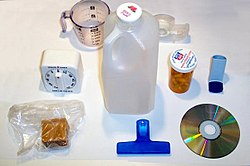Disposal
Duroplast is difficult to dispose of responsibly, a similar problem encountered with fiberglass. As discarded Trabants began to fill junkyards after 1991, creative solutions were devised for recycling them. One was developed by a Berlin biotechnology company, which experimented with bacteria to consume the body in twenty days. [5] [6] Urban legends, depicted in the movie Black Cat, White Cat and described in a song by the Serbian band Atheist Rap, described recycling Duroplast by feeding the cars to pigs, sheep and other farm animals.
In the late 1990s, Sachsenring's developed a disposal solution in which the body shells were shredded and used as an aggregate in cement blocks for pavement construction. This was featured in an episode of the program Scientific American Frontiers on the American PBS TV channel. [4]
This page is based on this
Wikipedia article Text is available under the
CC BY-SA 4.0 license; additional terms may apply.
Images, videos and audio are available under their respective licenses.

